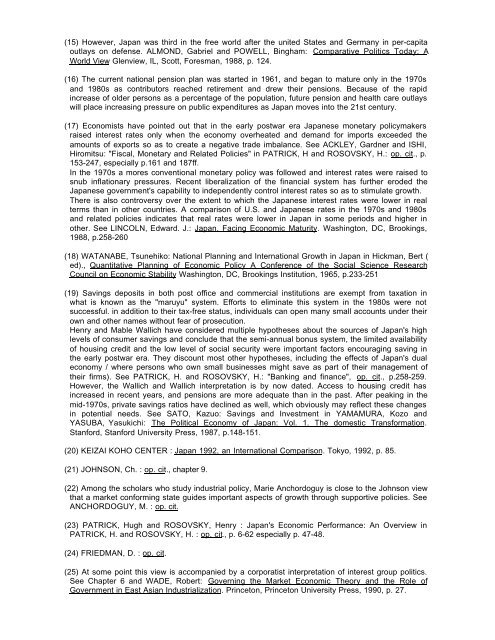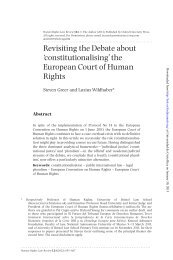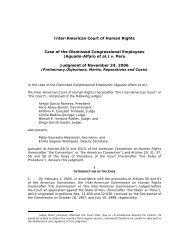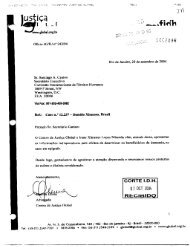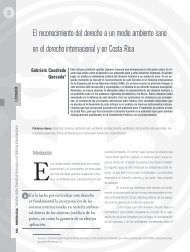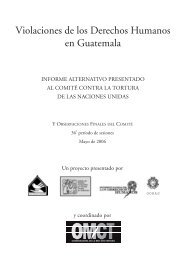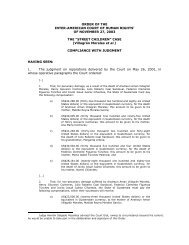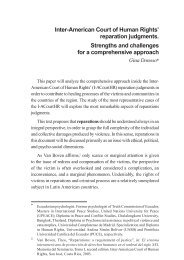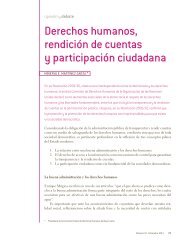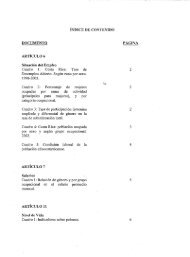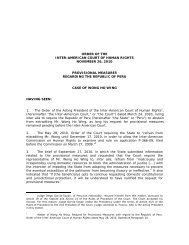The Political Economy of Japan Bradley M. RICHARDSON
The Political Economy of Japan Bradley M. RICHARDSON
The Political Economy of Japan Bradley M. RICHARDSON
- No tags were found...
You also want an ePaper? Increase the reach of your titles
YUMPU automatically turns print PDFs into web optimized ePapers that Google loves.
(15) However, <strong>Japan</strong> was third in the free world after the united States and Germany in per-capitaoutlays on defense. ALMOND, Gabriel and POWELL, Bingham: Comparative Politics Today: AWorld View Glenview, IL, Scott, Foresman, 1988, p. 124.(16) <strong>The</strong> current national pension plan was started in 1961, and began to mature only in the 1970sand 1980s as contributors reached retirement and drew their pensions. Because <strong>of</strong> the rapidincrease <strong>of</strong> older persons as a percentage <strong>of</strong> the population, future pension and health care outlayswill place increasing pressure on public expenditures as <strong>Japan</strong> moves into the 21st century.(17) Economists have pointed out that in the early postwar era <strong>Japan</strong>ese monetary policymakersraised interest rates only when the economy overheated and demand for imports exceeded theamounts <strong>of</strong> exports so as to create a negative trade imbalance. See ACKLEY, Gardner and ISHI,Hiromitsu: "Fiscal, Monetary and Related Policies" in PATRICK, H and ROSOVSKY, H.: op. cit., p.153-247, especially p.161 and 187ff.In the 1970s a mores conventional monetary policy was followed and interest rates were raised tosnub inflationary pressures. Recent liberalization <strong>of</strong> the financial system has further eroded the<strong>Japan</strong>ese government's capability to independently control interest rates so as to stimulate growth.<strong>The</strong>re is also controversy over the extent to which the <strong>Japan</strong>ese interest rates were lower in realterms than in other countries. A comparison <strong>of</strong> U.S. and <strong>Japan</strong>ese rates in the 1970s and 1980sand related policies indicates that real rates were lower in <strong>Japan</strong> in some periods and higher inother. See LINCOLN, Edward. J.: <strong>Japan</strong>, Facing Economic Maturity. Washington, DC, Brookings,1988, p.258-260(18) WATANABE, Tsunehiko: National Planning and International Growth in <strong>Japan</strong> in Hickman, Bert (ed)., Quantitative Planning <strong>of</strong> Economic Policy A Conference <strong>of</strong> the Social Science ResearchCouncil on Economic Stability Washington, DC, Brookings Institution, 1965, p.233-251(19) Savings deposits in both post <strong>of</strong>fice and commercial institutions are exempt from taxation inwhat is known as the "maruyu" system. Efforts to eliminate this system in the 1980s were notsuccessful. in addition to their tax-free status, individuals can open many small accounts under theirown and other names without fear <strong>of</strong> prosecution.Henry and Mable Wallich have considered multiple hypotheses about the sources <strong>of</strong> <strong>Japan</strong>'s highlevels <strong>of</strong> consumer savings and conclude that the semi-annual bonus system, the limited availability<strong>of</strong> housing credit and the low level <strong>of</strong> social security were important factors encouraging saving inthe early postwar era. <strong>The</strong>y discount most other hypotheses, including the effects <strong>of</strong> <strong>Japan</strong>'s dualeconomy / where persons who own small businesses might save as part <strong>of</strong> their management <strong>of</strong>their firms). See PATRICK, H. and ROSOVSKY, H.: "Banking and finance", op. cit., p.258-259.However, the Wallich and Wallich interpretation is by now dated. Access to housing credit hasincreased in recent years, and pensions are more adequate than in the past. After peaking in themid-1970s, private savings ratios have declined as well, which obviously may reflect these changesin potential needs. See SATO, Kazuo: Savings and Investment in YAMAMURA, Kozo andYASUBA, Yasukichi: <strong>The</strong> <strong>Political</strong> <strong>Economy</strong> <strong>of</strong> <strong>Japan</strong>: Vol. 1. <strong>The</strong> domestic Transformation.Stanford, Stanford University Press, 1987, p.148-151.(20) KEIZAI KOHO CENTER : <strong>Japan</strong> 1992, an International Comparison. Tokyo, 1992, p. 85.(21) JOHNSON, Ch. : op. cit., chapter 9.(22) Among the scholars who study industrial policy, Marie Anchordoguy is close to the Johnson viewthat a market conforming state guides important aspects <strong>of</strong> growth through supportive policies. SeeANCHORDOGUY, M. : op. cit.(23) PATRICK, Hugh and ROSOVSKY, Henry : <strong>Japan</strong>'s Economic Performance: An Overview inPATRICK, H. and ROSOVSKY, H. : op. cit., p. 6-62 especially p. 47-48.(24) FRIEDMAN, D. : op. cit.(25) At some point this view is accompanied by a corporatist interpretation <strong>of</strong> interest group politics.See Chapter 6 and WADE, Robert: Governing the Market Economic <strong>The</strong>ory and the Role <strong>of</strong>Government in East Asian Industrialization. Princeton, Princeton University Press, 1990, p. 27.


